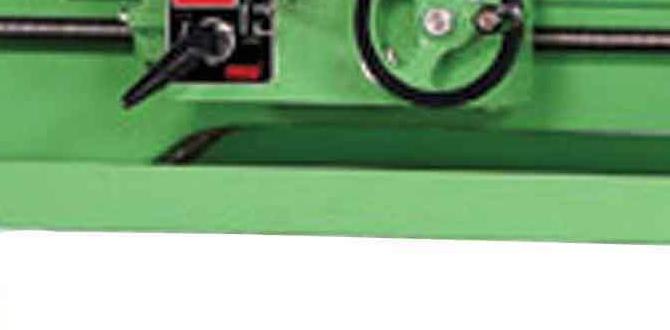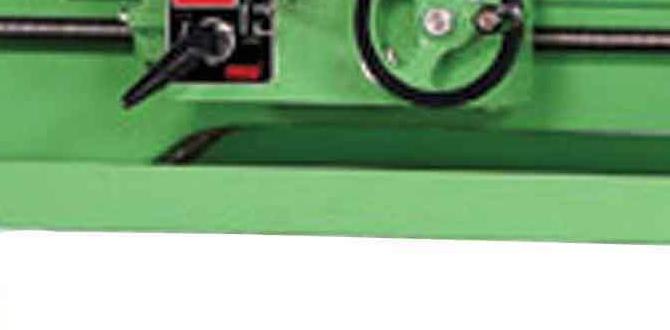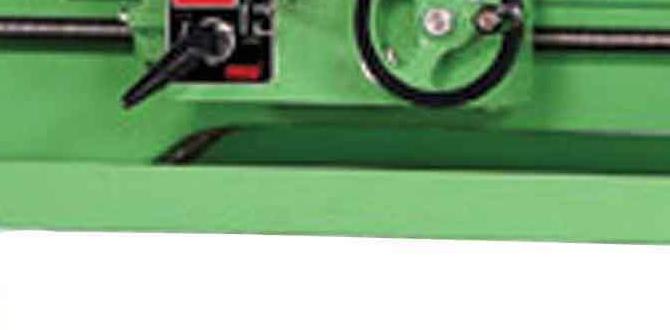Midi wood lathe with cast iron bed: The proven power of stability and durability for your woodworking projects. Discover why this combination delivers exceptional performance and value for hobbyists and serious woodturners alike.
Welcome to Lathe Hub! Ever found yourself staring at a wobbly lathe, wondering why your perfectly good wood is suddenly acting like a bucking bronco? It can be frustrating, right? Many woodturners, especially when starting out, face this challenge. A stable foundation is key to smooth cuts and beautiful finishes. That’s where a midi wood lathe with a cast iron bed truly shines. It offers the perfect blend of compact size and robust build, making woodworking a joy, not a battle. Don’t worry, we’ll walk through exactly why this is such a great choice and what makes it so powerful.
What is a Midi Wood Lathe with a Cast Iron Bed?
A midi wood lathe is a smaller, more compact version of a full-size wood lathe. It’s designed to be space-efficient, making it ideal for home workshops with limited room. The “cast iron bed” part is crucial. This refers to the main structural component of the lathe, the part that runs the length of the machine supporting the headstock, tailstock, and tool rest. When this bed is made from cast iron, it brings incredible benefits to your woodworking.
Think of it like building a house. You wouldn’t build a sturdy house on a flimsy foundation, would you? A cast iron bed provides that solid, unyielding base for your lathe. This stability is what allows you to achieve precise cuts, reduce vibrations, and generally have a much more enjoyable and safer woodworking experience. It’s the secret sauce that turns a good lathe into a great one, especially for those starting their turning journey.
Why Cast Iron is King for Lathe Beds
Cast iron is a strong, dense material that’s been a staple in machine tool construction for decades. Here’s why it’s such a fantastic choice for the bed of your midi wood lathe:
- Vibration Damping: Woodturning, especially with larger pieces or at higher speeds, can create significant vibrations. Cast iron is excellent at absorbing these vibrations. This means less shaking, smoother cuts, and a quieter operation.
- Weight and Stability: Cast iron is heavy. This inherent weight adds mass to the lathe, anchoring it firmly to your workbench or stand. More mass means more stability, reducing the tendency for the lathe to “walk” or vibrate uncontrollably.
- Durability and Longevity: Cast iron is incredibly durable. It’s resistant to scratches, impacts, and wear. A lathe with a cast iron bed is built to last, making it a wise, long-term investment for your workshop.
- Precision: The rigidity of cast iron allows machine beds to be manufactured with a high degree of precision. This ensures that the headstock and tailstock are perfectly aligned, which is essential for accurate turning.
- Thermal Stability: While less critical for woodworking than metalworking, cast iron is also relatively stable when subjected to temperature changes, which contributes to overall precision.
The Midi Package: Size Meets Strength
Combining the compact nature of a midi lathe with the robust engineering of a cast iron bed offers a unique set of advantages, especially for hobbyists and those with limited workshop space. It’s about getting the best of both worlds.
Benefits of Midi Size:
- Space Saving: Midi lathes are significantly smaller than their full-size counterparts, fitting easily on a workbench or in a dedicated corner.
- Portability: Many midi lathes are light enough to be moved around the workshop or even taken to demonstrations or classes.
- Affordability: Generally, midi lathes come with a lower price tag, making them an accessible entry point into woodturning.
- Focused Functionality: They are often designed with essential features for basic turning tasks, making them less intimidating for beginners.
How Cast Iron Enhances the Midi Format:
- Undiluted Stability: Even a smaller lathe benefits immensely from a heavy, stable base. A cast iron bed prevents a lighter midi lathe from being overpowered by the workpiece or vibrations.
- Enhanced Performance: You get the feel and quality of a much larger, more expensive machine, thanks to the reduced vibration and increased rigidity provided by the cast iron.
- Greater Confidence: Beginners can learn with more confidence, knowing their machine is less likely to be pushed around or develop issues from instability.
- Project Versatility: While midi lathes naturally have a shorter turning length and swing, a cast iron bed allows them to handle a wider range of projects within their capacity more effectively than lightweight alternatives.
Key Features to Look For
When you’re in the market for a midi wood lathe with a cast iron bed, there are a few specific features that will make a big difference in your woodworking experience. Looking for these will help you find a machine that’s not just powerful, but also user-friendly and reliable.
Motor Power and Speed Control:
For a midi lathe, a motor in the range of 0.5 to 1.5 horsepower is typical. More power means you can handle slightly larger workpieces and cut tougher woods. Variable speed control is almost a must-have. It allows you to adjust the lathe’s speed on the fly, which is crucial for safety (slower speeds for rough shaping and sanding) and for the best cutting results on different wood types.
Look for:
- Horsepower: 1/2 HP is a good starting point for small to medium projects. 3/4 HP or 1 HP offers more versatility.
- Variable Speed: Belt-driven lathes often have several speed ranges, while electronically variable speed (EVS) lathes offer continuous adjustment, which is more convenient.
- RPM Range: A wider RPM range (e.g., 250-3850 RPM or similar) gives you more control over your turning.
Turning Capacity: Swing and Distance Between Centers:
These two specs tell you the maximum size of the workpiece you can turn.
The swing is the diameter of the largest workpiece that can be turned. It’s measured by the distance from the bed to the center of the spindle, then doubled.
The distance between centers (or bed length) is the maximum length of a workpiece that can be mounted between the headstock and tailstock.
For a midi lathe:
- Swing: Typically ranges from 8 to 12 inches.
- Distance Between Centers: Usually between 16 to 24 inches.
Ensure these capacities match your intended projects. You can often extend the distance between centers on some models with optional bed extensions.
Headstock and Tailstock Features:
The headstock houses the motor and drive mechanism, while the tailstock supports the other end of your workpiece.
Key features include:
- Spindle Threads: Most lathes use standard threads for attaching chucks and faceplates. A common size is 1” x 8 TPI (threads per inch). Ensure this matches the accessories you plan to use.
- Morse Taper: Both the headstock and tailstock spindles usually have a Morse Taper (MT) socket. MT2 is very common for midi lathes. This allows for secure mounting of accessories like drive centers and drill bits.
- Indexing Head: Some lathes have an indexing head on the headstock. This allows you to lock the spindle at specific intervals (e.g., every 15 or 30 degrees) for tasks like fluting, carving, or drilling evenly spaced holes.
- Tailstock Quill Travel: This is the amount the tailstock spindle can extend. A decent quill travel (around 2-3 inches) is helpful for securely mounting and adjusting work.
Tool Rest and Tool Rest Base:
The tool rest is where you support your turning tools as you shape the wood.
Look for:
- Sturdy Tool Rest: A robust, preferably cast iron, tool rest that can be easily adjusted in height and rotated around the lathe’s bed is essential.
- Secure Locking Mechanism: The tool rest needs to lock firmly in place. Any wobbling here will make turning difficult and unsafe.
- Smooth Operation: The base that slides along the lathe bed should move smoothly to allow quick repositioning.
Considering these features will help you select a midi wood lathe with a cast iron bed that provides a solid foundation for your turning endeavors.
Setting Up Your Midi Wood Lathe with Cast Iron Bed for Success
Getting your new lathe set up correctly is just as important as choosing the right machine. A proper setup ensures safety, enhances performance, and makes your woodworking experience much smoother. Since you’ve invested in a cast iron bed, let’s make sure it’s performing at its best.
Unpacking and Inspection:
Before you even plug anything in, carefully unpack all the components. Check for any shipping damage and ensure all parts are accounted for according to the manufacturer’s manual. Familiarize yourself with each piece.
Mounting Your Lathe:
This is where the cast iron bed really shows its strength.
Here are a few common ways to mount your midi lathe:
- Workbench Mounting: Many midi lathes are designed to be bolted directly to a sturdy workbench. Use strong, appropriate screws or bolts to secure the lathe’s base to the bench. Ensure the bench itself is stable and won’t wobble.
- Dedicated Stand: Some midi lathes come with their own stands, often made of steel. If your lathe has a cast iron bed, the stand should be equally robust. If the stand doesn’t feel substantial enough, consider bolting it to the floor or to a heavy, stable base.
- Portable Base with Vibration Dampening: For ultimate flexibility, you can mount your lathe on a portable standalone base. To maximize the benefits of the cast iron bed, place vibration-dampening pads (like thick rubber mats) between the lathe (or its stand) and the floor or workbench. This further reduces any potential for shaking.
A rule of thumb: if the lathe or the surface it’s on moves while you’re turning, it’s not stable enough.
Aligning Headstock and Tailstock:
For perfect cuts and to prevent issues like workpieces flying off, the headstock and tailstock must be perfectly aligned. This is usually done by ensuring the center lines of both spindles are at the same height and perfectly parallel. Most midi lathes with cast iron beds are factory-aligned, but it’s always good to check.
- Loosen the tailstock clamping lever.
- Advance the tailstock quill fully in.
- Place a dial indicator (if you have one) or a piece of paper between the headstock and tailstock centers.
- Rotate the headstock spindle by hand. The paper should have consistent contact, or the dial indicator should show minimal runout.
- If there’s an issue, most tailstocks have small adjustment screws to slightly tilt the tailstock body to achieve perfect alignment.
Electrical Safety:
Always ensure your lathe is plugged into a properly grounded outlet. If your workshop has older wiring, consider using a heavy-duty extension cord rated for the lathe’s power draw. Never operate a lathe with a damaged power cord.
For general safety guidelines on workshop tools, the Occupational Safety and Health Administration (OSHA) provides comprehensive machine guarding requirements that apply to many woodworking tools.
Initial Testing:
Before turning any wood, run the lathe at its lowest speed for a few minutes. Listen for any unusual noises. Check that the tool rest holder moves smoothly and locks securely. Gently apply a light pressure with a finger (not a tool) to the rotating spindle to see how much vibration there is. A cast iron bed should exhibit minimal vibration.
Using Your Midi Wood Lathe with Cast Iron Bed Safely and Effectively
Now that your lathe is set up, it’s time to turn! Safety is always the top priority in any workshop, and woodturning is no exception. A solid cast iron bed makes this much easier, but you still need to follow best practices.
Personal Protective Equipment (PPE):
Always wear appropriate PPE:
- Safety Glasses: Non-negotiable. Wear a full face shield for the best protection against flying chips.
- Dust Mask or Respirator: Wood dust can be harmful.
- Hearing Protection: Lathes can be noisy.
- No Loose Clothing, Jewelry, or Gloves: These can get caught in the rotating workpiece or lathe.
Mounting Your Workpiece:
Properly securing your wood is critical. Whether you’re using a faceplate, chuck, or drive center:
- Ensure the mounting hardware is clean and free of debris.
- Tighten securely.
- For faceplates and chucks, check that they spin true without excessive wobble.
- For between-centers turning, ensure the centers are sharp and properly engaged with the wood.
- Start at the lowest speed setting for initial shaping and gradually increase speed as the workpiece becomes more round and balanced.
Tool Technique:
Learn to use your turning tools correctly. A sharp tool is safer and more effective.
Basic turning tools include:
- Gouge: For roughing out shapes and creating curves.
- Skew Chisel: For smoothing cylindrical surfaces and creating fine details.
- Scrapers: Used for final smoothing, especially on end grain.
Always keep your tools sharp. A dull tool requires more force, leading to tear-out and potential loss of control. Position the tool rest close to the workpiece (about the thickness of a pencil) to provide good support for your tools and prevent them from catching.
Speed Management:
This is where your cast iron bed’s stability really pays off. A well-balanced workpiece can be turned at higher speeds, but always start slow.
- Roughing: Begin at the slowest speed. As you remove material, the workpiece might become unbalanced, so you may need to slow down again.
- Shaping: As the piece becomes rounder, you can gradually increase speed.
- Sanding: Lower speeds are generally best for sanding to prevent burning and excessive dust generation.
- Listen to Your Lathe: If the lathe starts to vibrate excessively, even with a cast iron bed, and the noise level increases significantly, it’s a sign to slow down or stop and check your workpiece and tool rest.
Sanding and Finishing:
Sanding is often done off the lathe, or at very low speeds. Applying finishes can be done on the lathe. Use light coats and allow adequate drying time between applications. The stability of your cast iron bed will make applying these finishes much easier and more uniform.
A Midi Wood Lathe with Cast Iron Bed in Action: Project Ideas
The combination of a compact size and robust build makes a cast iron bed midi wood lathe incredibly versatile for a wide range of projects. Here are a few ideas that showcase its capabilities:
Simple Projects for Beginners:
- Pens: Turning pen kits is a classic beginner project. They are small, quick to turn, and a great way to practice basic spindle turning techniques. The accuracy of a cast iron bed helps achieve a smooth, seamless fit for the pen components.



